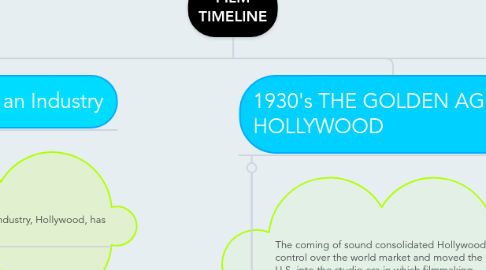
1. ORIGIN OF FILMS
1.1. Lumiere Brothers started film with the invention of the Cinématographe around the 1920's. The first film ever shot was the one named, workers leaving the factory.
2. Silent Period Film (1895-1929)
2.1. The earliest American films, appeared around 1895, they were a working-class pastime. Since they told stories without words, they appealed to the illiterate immigrant population. After 1900, film became a middle-class phenomenon, as filmmakers exploited film’s storytelling potential by adapting novels
2.1.1. Until 1914, the major film industries resided in Italy, France, and the United States. However, World War I devastated the Italian and French film industries, allowing American producers to gain the upper hand on the global market.
2.2. Until 1914, the major national film industries resided in Italy, France, and the United States. However, World War I devastated the Italian and French film industries, allowing American producers to gain the upper hand on the global market.
2.3. Mayor movements
2.3.1. German Expressionism
2.3.2. Soviet Montage
2.3.3. French Avant-Garde
2.4. Modernism
2.4.1. A philosophical movement that, along with cultural trends and changes, arose from wide-scale and far-reaching transformations in Western society in the late 19th and early 20th centuries. Among the factors that shaped modernism were the development of modern industrial societies and the rapid growth of cities, followed then by the horror of World War I.
3. Hollywood as an Industry
3.1. Since the 1920s, one industry, Hollywood, has dominated the world.
3.2. Consist of three componentes
3.2.1. PRODUCTION
3.2.2. DISTRIBUTION .
3.2.3. PRESENTATION
4. 1930's THE GOLDEN AGE OF HOLLYWOOD
4.1. The coming of sound consolidated Hollywood’s control over the world market and moved the U.S. into the studio era in which filmmaking, distribution, and exhibition were dominated by five theatre corporations Paramount, Loew’s Fox Film Warner Bros., and RKO. They ruled Hollywood during the 1930s and 1940s and operated around the world as fully integrated business enterprises.
4.2. Minor studios
4.2.1. • Columbia • Universal • United Artists
4.2.2. Important Movies
4.2.2.1. Early Gangster Films at Warner: Scarface (1932).
4.2.2.2. • Josef von Sternberg and Marlene Dietrich: The Blue Angel (Germany, 1929) Morocco (1930).
4.2.2.3. • Universal's Horror Films: Escapist entertainment Dracula (1931). The film starred Bela Lugosi in a star-making role as the vampire Count Dracula, Universal's next feature was James Whale's gothic Frankenstein (1931). Then the Mummy (1932) and Freaks (1932).
4.2.2.4. Clark Gable - Example of a Mega-Star: Susan Lenox: Her Fall and Rise (1931) with co-star Greta Garbo, then in a hot romantic pairing opposite Joan Crawford in Possessed (1931)Red Dust (1932). Manhattan Melodrama (1934). No Man of Her Own (1932. It Happened One Night (1934) Test Pilot (1938), Gone with the Wind (1939).
4.2.2.5. • Fred Astaire and Ginger Rogers: The Dance Duo
4.2.2.6. More facts about the 30's
4.2.2.6.1. • Mae west and the Marx Brothers • Laurel and Hardy • Screwball Comedy • Adventure Films, Epics, and Westerns:
5. 1940's
5.1. Relevant Movies in this time: Casablanca (1942) The Great Dictator by Charlie Chaplin The thief of Bagdad (1940) Citizen Kane The Maltese Falcon The Big Sleep Red River Rio Grande Grapes of Wrath Meshes of the Afternoon Rebecca by Alfred Hitchcock Shadow of a Doubt Great Expectations Rome, open city and Bicycle thief as italian films.
5.2. B-Movies
5.2.1. Usually movies or short films shown before the actual film, commonly made with a low budget and little cast or low payment actors.
5.3. Film NOIR
5.3.1. The film noir genre generally refers to mystery and crime dramas produced from the early 1940s to the late 1950s. Movies of this genre were characteristically shot in black and white, and featured stories involving femmes fatales, doomed heroes or anti-heroes, and tough, cynical detectives.
